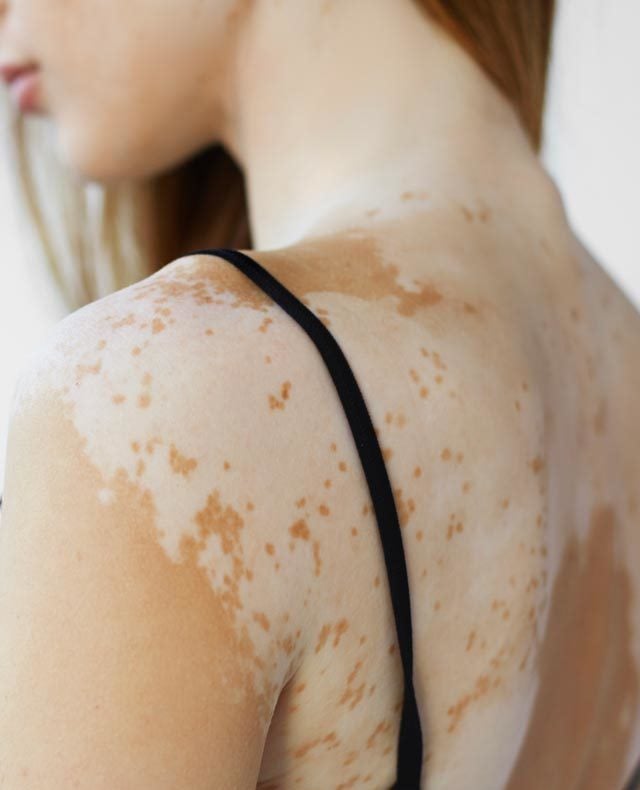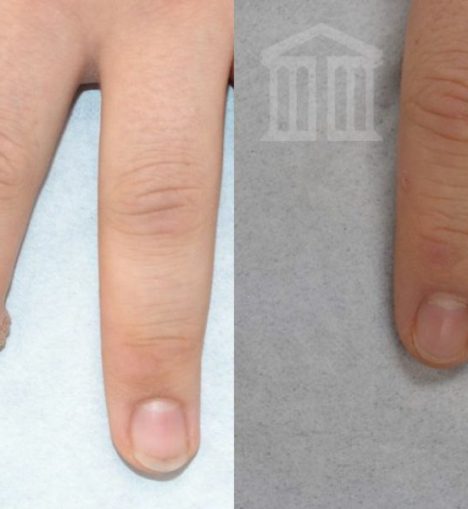Vitiligo
Vitiligo is a long term usually very distressing illness that results in depigmentation of the skin.

These can be anywhere but are often on hands, face or feet.
The patches get bigger with time or spread (unstable vitiligo) then stop spreading (stable vitiligo). Depression and stigma are common, especially in darker skinned individuals where visibility is most pronounced.
With non-segmental vitiligo there is usually symmetry in the location of patches. It can start at any age.
Causes
Often as irregular patches, but it can also be symmetrical. It is caused by death of melanocytes, the cells that give skin its pigment or suntan. We do not know the cause of vitiligo, but it is suggested that it is linked with other autoimmune illnesses such as thyroid disease and diabetes. There is also a genetic bias.
The main symptoms of vitiligo are loss of pigment in patches.
Treatments
However there are a number of treatments that improve the appearance of the condition. In fair-skinned people, avoiding tanning of normal skin can make patches of vitiligo less noticeable.
There are 4 main methods of treatment.
ReCell Therapy
This method takes all the cells from the skin and transplants them on to the stable vitiligo. ReCell was developed for treating 2nd degree burns and is used in the NHS in special burns centres. There are good reasons to suggest that the effects of ReCell on vitiligo may last longer than melanocyte grafting per se.
Protocol for recell therapy for Vitiligo
3 basic requirements for us to consider ReCell Therapy are:
- Failure of topical therapy such as Steroids and immunomodulators such as protopic
- Failure of conventional phototherapy
- Vitiligo must be stable for 1 year.
Success rates appear to be significant in the most resistant patients.
Sunblock
Sun-block (SPF 30 or above) is applied to areas of vitiligo to prevent burning.
Skin camouflage
In some cases where the individual has a few vitiligo patches and slightly pigmented skin, they can be hidden with makeup or camouflage solutions.
Steroids
The traditional treatment used by dermatologists is the application of potent topical corticosteroid creams.
Why choose Zenith Cosmetic Clinics For Vitiligo Treatment?
- All consultations and reviews are included in the price
- All consultants are UK trained
- Rated as outstanding by the Care Quality Commission (CQC) in providing care to our patients in a safe and effective manner.
- Registered with the Care Quality Commission (CQC)
- Full member of the British College of Aesthetic Medicine (BCAM)
FAQ’s
What are the different types of non-segmental Vitiligo (SNV)
- Generalized Vitiligo: This is the most common pattern.
- Universal Vitiligo: Here loss of pigment covers most of the body (sometimes referred to as vitiligo Universalis).
- Mucosal Vitiligo: depigmentation of only the mucous membranes (eg mouth)
- Acrofacial Vitiligo: Affects fingers and anal areas.
- Focal Vitiligo: a few scattered patches spread around, often in children.
- Segmental vitiligo (SV) is quite different from NSV.
What is the difference between SV to SNV?
- SV affects areas of skin that are associated with nerves from the spine.
- SV spreads much more rapidly than NSV.
- SV is much more stable once settled and amenable to topical treatment. It also tends not to be associated with autoimmune illnesses.
What are the Immunomodulator Creams for treatment?
Melanocyte Grafting
A biopsy is taken, the melanocytes are removed, grown, and put back onto the depigmented skin. Good results have been documented on stable vitiligo, with the transplanted melanocytes lasting several years.
Ultraviolet light
UVA treatments have been used and are giving way to narrow band UVB treatment combined with immunomodulators. Obviously, overexposure is dangerous but this is calculated and a maximum dose is delivered over the course of a year, perhaps 1 or 2 treatments per week much in the same way as a treatment for severe psoriasis.
Skin Bleaching
In cases of vitiligo Universalis, the tempting option is to de-pigment the unaffected skin with topical drugs such as hydroquinone (these are sadly no longer available in the UK).
The removal of all the skin pigment with chemicals is permanent and protection must be used for life to avoid malignant melanomas.
Depigmentation takes about a year. Q-switched tattoo lasers have also been used with varying success to remove small areas of remaining pigmented skin.
Psychological
It is critical to assess the mental health of those with vitiligo. As with severe acne, there is an increased rate of suicide, especially in late teens or in women of Asian origin.

Patient Testimonials
What our patients have to say...
The goings on at Zenith
Zenith Journal

The Zenith Journal
UK Hair Transplant VS Turkey- Is the UK overcharging for treatment?
Read the story







